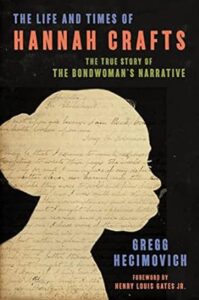The Life and Times of Hannah Crafts: The True Story of The Bondswoman’s Narrative – Gregg Hecimovich
The Life and Times of Hannah Crafts: The True Story of The Bondswoman’s Narrative. By Gregg Hecimovich. (New York: Ecco, 2023. 353 pp. Cloth, $40.00.)
As extolled in a recent New York Times review, the best part of Gregg Hecimovich’s The Life and Times of Hannah Craft is how how he lays bare the research process he used to discover the identify of the author of the The Bondwoman’s Narrative. Every historian is responsible for making their research process transparent, to detail their methodology so future scholars can trace the same historical trail to either affirm an historian’s conclusions, offer challenges, or add new and important information. The stakes were high for Hecimovich, but I think he does a good job of foregrounding the methods he used to explain how he discovered Crafts’ identity. This alone makes his book an invaluable source to help us understand how to pursue such difficult history.
My faults with Hecimovich therefore lie in more technical details, as I am nowhere near an expert in this topic and cannot offer a counternarrative or corroborating evidence to evaluate the veracity of his discoveries or his narrative. What I do take issue with is how the book was written from a technical standpoint. Hecimovich jumps between time periods with little indication of what time he is landing in, and the immense cast of characters can be extremely difficult to keep track of. I often times had to read a passage several times to figure out its subject. These may seem like minor quibbles, but I think, especially when keeping track of who is who in relation to one’s ability to verify the role of each historical actor, it is important to make this observation.
My other recommendation would be to read The Bondwoman’s Narrative before you read this book. Hecimovich also jumps between which parts of the novel he is describing, and without having the textual context that would come from reading the novel, I often found myself a bit lost.
Overall, however, I think this book is important because, as I stressed earlier, it lays bare the historical research process, especially important when facing such a difficult group of sources. Hecimovich writes that Crafts’ work “bears surprising similarities to that of the famous author Harriet Beecher Stowe – only, from the other side of the color line,” and Hecimovich spends an entire chapter on this comparison (153). He places Craft as a slave educated in reading and writing with an unusual access to reading material in the personal library of her enslaver. Focusing on the connection between these two novels allows Hecimovich to speculate on Craft’s literary heritage.
This comparison might raise more questions than it does answers, and Hecimovich is forthcoming in his extrapolations, though without losing his convictions about the origins of the novel and Crafts’ identity. By laying his historical process so bare to the reader, he invites future researchers to test his hypothesis, and to use similar transparency when writing about their own chosen topics.

